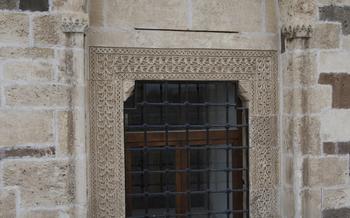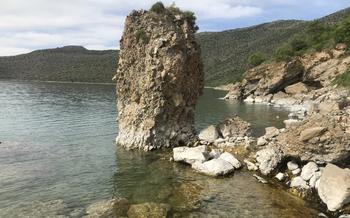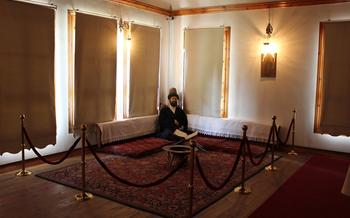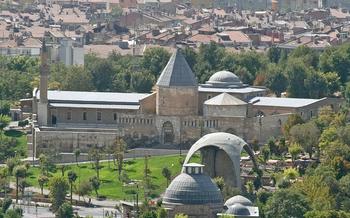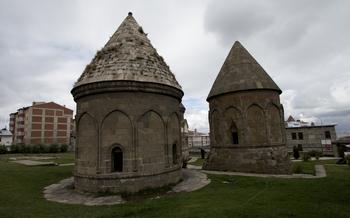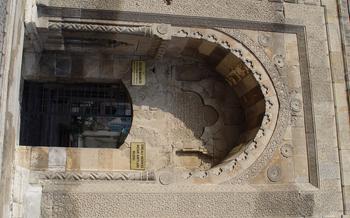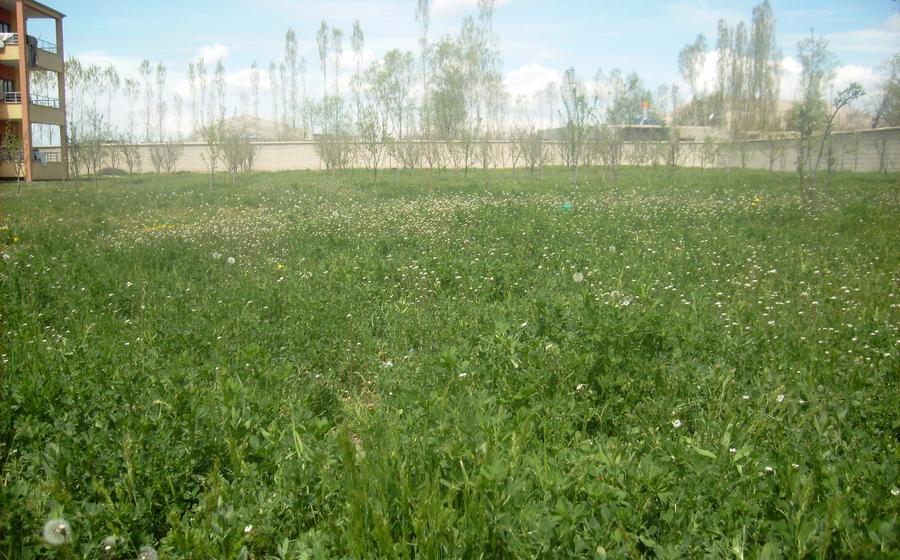
Halime Hatun Tomb
- Historical Significance
- Location and Accessibility
- Architectural Marvel
- Interior Beauty
- Historical Context
- Preservation and Restoration
- Local Legends and Folklore
- Cultural Significance
- Nearby Attractions
- Visitor Facilities
- Photography and Videography
- Best Time to Visit
- Dress Code and Etiquette
- Local Cuisine and Dining
- Insider Tip
Historical Significance
The Halime Hatun Tomb stands as a testament to the rich history and cultural heritage of Turkey. Erected in the 11th century, this architectural marvel serves as a poignant reminder of the Seljuk Empire's reign. It was commissioned by Sultan Alp Arslan in memory of his beloved wife, Halime Hatun, who played a significant role in the Seljuk court. The tomb's grandeur and intricate detailing symbolize the power and influence of the Seljuk dynasty during its reign over Anatolia. As visitors step inside the tomb, they are transported back in time, experiencing the essence of Seljuk artistry and paying homage to a remarkable woman who left an indelible mark on Turkish history.
Location and Accessibility
The Halime Hatun Tomb is situated in the heart of Van, Turkey, a city steeped in history and cultural heritage. It is conveniently located in the city center, making it easily accessible for visitors. To reach the tomb, you can take a leisurely stroll or utilize the city's public transportation system. The tomb is in close proximity to other notable landmarks, including the Van Castle, the Van Museum, and the Great Mosque of Van. Visitors can follow clear signage or ask friendly locals for directions to ensure a hassle-free visit. Whether you choose to explore the city on foot or use public transport, the Halime Hatun Tomb is a must-visit destination that offers a unique glimpse into Turkey's rich past.
Architectural Marvel
The Halime Hatun Tomb stands as a remarkable testament to the architectural prowess of the Seljuk Empire. Its distinctive shape, resembling a miniature fortress, immediately captivates the attention of visitors. The tomb's exterior is adorned with intricate carvings and inscriptions, showcasing the exceptional craftsmanship of Seljuk artisans. The main entrance, framed by a magnificent arch, leads visitors into a spacious chamber that exudes an aura of solemnity and grandeur. The interior walls are adorned with decorative tiles, intricate calligraphy, and vibrant frescoes depicting scenes from Islamic history and mythology. The tomb's construction materials, including finely cut stone and marble, contribute to its durability and elegance, ensuring that it has withstood the test of time. The Halime Hatun Tomb is a true architectural masterpiece that embodies the artistic and cultural heritage of the Seljuk dynasty.
Interior Beauty
The interior of the Halime Hatun Tomb is as captivating as its exterior. Upon entering, visitors are greeted by a spacious chamber that exudes an aura of serenity and grandeur. The walls are adorned with intricate carvings and inscriptions that narrate tales of Halime Hatun's life and legacy. The ceiling, a masterpiece of Seljuk artistry, features stunning geometric patterns and delicate floral motifs.
One of the most striking features of the tomb's interior is the cenotaph, a symbolic representation of Halime Hatun's final resting place. The cenotaph is elaborately carved with verses from the Quran and intricate arabesques. Above it hangs a magnificent chandelier, casting a warm glow over the chamber.
In addition to the cenotaph, the tomb's interior is embellished with a variety of decorative elements that showcase the Seljuk's mastery of craftsmanship. These include colorful tiles, ceramic panels, and stucco moldings. Each element is meticulously crafted and placed, contributing to the overall harmony and beauty of the space.
The interior of the Halime Hatun Tomb is not merely a visual spectacle; it is also a testament to the deep spiritual and cultural significance of the site. The inscriptions and carvings serve as reminders of Halime Hatun's piety and devotion, while the overall design of the chamber reflects the Seljuk's reverence for their rulers and their faith.
Exploring the interior of the Halime Hatun Tomb is a journey through time, art, and spirituality. It is an experience that leaves visitors in awe of the Seljuk dynasty's architectural prowess and the enduring legacy of Halime Hatun.
Historical Context
The Seljuk Empire, a powerful dynasty of Turkic origin, ruled over a vast territory stretching from Central Asia to Anatolia during the 11th and 12th centuries. During their reign, the Seljuks left a lasting impact on the region, contributing significantly to its political, cultural, and architectural landscape. The construction of the Halime Hatun Tomb in Van stands as a testament to their architectural prowess and their commitment to Islamic traditions.
The Seljuks, known for their military prowess and administrative skills, established a centralized government that fostered stability and prosperity. Their reign ushered in a period of cultural and intellectual flourishing, marked by the patronage of arts, sciences, and literature. The Seljuks adopted and synthesized various cultural influences from their diverse empire, resulting in a unique blend of Persian, Arab, and Turkish traditions.
The construction of the Halime Hatun Tomb reflects the Seljuks' deep-rooted Islamic faith and their commitment to monumental architecture. The tomb's intricate design and lavish decoration showcase the artistic sensibilities and technical expertise of Seljuk artisans. The choice of Van as the site for the tomb further underscores the Seljuks' strategic and symbolic considerations, as the city held significant political and cultural importance within their empire.
Preservation and Restoration
The Halime Hatun Tomb has undergone several conservation efforts and restoration projects to preserve its architectural integrity and historical significance. In the early 20th century, the tomb faced significant deterioration due to weathering and neglect. Recognizing its importance, local authorities initiated restoration work to stabilize the structure and repair any damages.
In recent years, more extensive restoration efforts have been undertaken to ensure the tomb's longevity. These projects have involved meticulous cleaning and restoration of the tomb's exterior surfaces, including the intricate carvings and inscriptions. The interior has also received attention, with experts working to conserve the decorative elements and ensure the stability of the chamber.
Preserving historical sites like the Halime Hatun Tomb is essential for maintaining the cultural heritage of the region. These efforts not only protect the physical structure but also ensure that future generations can continue to appreciate and learn from this architectural masterpiece.
Balancing the need for preservation with accessibility for visitors can be challenging. However, by implementing sustainable conservation practices and providing controlled access, authorities can strike a balance that allows visitors to experience the tomb's beauty while ensuring its long-term preservation.
Local Legends and Folklore
Intriguing local legends and folklore surround the Halime Hatun Tomb, adding to its mystique and cultural significance. One popular tale speaks of a secret tunnel leading from the tomb to the Van Castle, built by Halime Hatun's husband, Sultan Alp Arslan. According to the legend, the tunnel was used for discreet communication and transportation between the two sites.
Another legend tells of a hidden treasure buried beneath the tomb. It is said that Halime Hatun, known for her generosity and wealth, left behind a vast fortune, which was buried with her in the tomb. Over the centuries, many have searched for this treasure, but none have succeeded.
These stories and legends have become an integral part of the local culture, passed down through generations. They not only enhance the tomb's allure but also reflect the rich storytelling tradition of the region, where history and myth intertwine to create a captivating tapestry of cultural heritage.
Cultural Significance
The Halime Hatun Tomb stands as a remarkable symbol of Turkish heritage and Islamic architecture. Its intricate carvings, refined craftsmanship, and Seljuk architectural style reflect the rich cultural traditions of the region. The tomb's enduring presence serves as a reminder of the contributions made by the Seljuk dynasty to the development of Islamic art and architecture.
Beyond its historical significance, the Halime Hatun Tomb holds immense cultural value. It represents the cultural identity of the Van region and is deeply intertwined with the local community. The tomb attracts visitors from all over Turkey and beyond, who come to admire its beauty, learn about its history, and pay their respects to Halime Hatun, a revered figure in Turkish history.
The tomb's cultural significance is further enhanced by the various cultural events and festivals held at the site. These events celebrate the heritage of the region and showcase traditional Turkish music, dance, and art forms. Visitors can immerse themselves in the vibrant culture of Van and gain a deeper understanding of the history and traditions that have shaped the region.
Through its architectural grandeur, historical significance, and cultural events, the Halime Hatun Tomb serves as a bridge between the past and the present, promoting cultural understanding and appreciation. It stands as a testament to the enduring legacy of the Seljuk Empire and the rich cultural heritage of Turkey.
Nearby Attractions
In addition to the Halime Hatun Tomb, Van is home to a variety of other attractions that visitors can explore. The Van Museum is a must-see for history buffs, as it houses a collection of artifacts from the region's rich past, including the famous Van Cat Urartu sculpture. Nature lovers will appreciate the stunning Lake Van, the largest lake in Turkey and a popular spot for swimming, boating, and fishing. For those interested in architecture, the city of Van boasts several historic mosques, churches, and caravanserais, including the Great Mosque of Van and the Van Fortress.
To make the most of your time in Van, consider creating a personalized itinerary or joining a guided tour. The city is easily walkable, allowing you to explore many attractions on foot. Alternatively, you can rent a bicycle or take advantage of the public transportation system to venture further afield. Whether you choose to wander independently or follow a guided path, Van offers a wealth of experiences for every traveler.
Visitor Facilities
The Halime Hatun Tomb offers several visitor facilities to enhance the overall experience. Restrooms are available on-site, ensuring convenience for visitors during their visit. For those arriving by car, ample parking space is provided in the vicinity of the tomb, making it easy to park and explore the site.
Guided tours are available for visitors who wish to delve deeper into the history and significance of the tomb. These tours are led by knowledgeable guides who provide insightful commentary and anecdotes, bringing the tomb's story to life. The guides can answer questions and offer a personalized experience, ensuring that visitors gain a comprehensive understanding of the site.
The Halime Hatun Tomb is committed to accessibility, and efforts have been made to ensure that visitors with disabilities or special needs can comfortably explore the site. Wheelchair ramps and accessible pathways have been installed to facilitate easy movement within the tomb's premises. Additionally, visitors with hearing impairments can request assistive listening devices to enhance their tour experience.
Admission to the Halime Hatun Tomb is subject to a nominal entrance fee. This fee helps maintain the site, preserve its historical integrity, and support ongoing conservation efforts. Visitors can purchase tickets at the entrance, and discounts or concessions may be available for students, seniors, or groups.
Photography and Videography
The Halime Hatun Tomb presents a wealth of opportunities for photography and videography enthusiasts. The stunning architecture, intricate carvings, and peaceful ambiance of the site make it an ideal subject for capturing memorable images. Visitors are permitted to take photos and videos inside the tomb, allowing them to document their visit and share the beauty of this historical landmark with others.
When photographing or filming inside the tomb, it is important to be respectful of the sacred nature of the site. Visitors should avoid using flash photography or tripods, as these can be disruptive to other visitors and may damage the tomb's delicate interior. It is also important to be mindful of the privacy of other visitors and to avoid capturing their faces or personal information in your shots.
For the best photography results, consider visiting the tomb during the golden hours of sunrise or sunset, when the warm light casts a magical glow on the tomb's exterior. The interior of the tomb is relatively dark, so it may be necessary to use a tripod or adjust your camera settings to capture clear and well-lit images.
If you plan to create videos at the Halime Hatun Tomb, it is important to be aware of the tomb's acoustics. The spacious chamber can create echoes, so it is important to speak clearly and concisely when recording audio. Additionally, consider using a microphone to ensure that your audio is clear and free of background noise.
Best Time to Visit
The best time to visit the Halime Hatun Tomb, like most of Turkey, is during the shoulder seasons of spring (April-May) and autumn (September-October). During these months, the weather is pleasant and mild, with warm days and cool nights. The crowds are also smaller, allowing for a more peaceful and intimate experience.
If you're interested in witnessing the tomb in all its glory, consider visiting during the annual Halime Hatun Festival, typically held in June or July. This vibrant festival celebrates the life and legacy of Halime Hatun and features traditional music, dance, and cultural performances. The tomb becomes the focal point of the festivities, adorned with colorful decorations and illuminated with enchanting lights.
To avoid the crowds and scorching summer heat, it's best to steer clear of visiting during the peak tourist season from June to August. However, if you do find yourself in Van during this time, aim to visit the tomb early in the morning or late in the evening when the temperatures are more bearable.
Dress Code and Etiquette
When visiting the Halime Hatun Tomb, it is essential to be mindful of the local customs and traditions to ensure a respectful and enjoyable experience. Visitors should dress modestly and avoid wearing revealing or overly casual clothing. This is a religious site, so it is important to show respect by dressing appropriately.
It is also important to be respectful of the tomb's sacred space by maintaining a quiet and contemplative atmosphere. Avoid loud talking, laughing, or engaging in disruptive behavior. Visitors should also refrain from touching or leaning on the tomb's walls or any of its decorative elements.
By adhering to these simple guidelines, visitors can demonstrate their respect for the Halime Hatun Tomb and its cultural significance while ensuring a peaceful and meaningful visit for all.
Local Cuisine and Dining
After exploring the historical wonders of the Halime Hatun Tomb, visitors can savor the delights of traditional Turkish cuisine at nearby restaurants and cafes. Van offers a rich culinary scene with a diverse range of flavors and dishes that reflect the region's cultural heritage.
One must-try dish is the famous "Van kahvaltısı" (Van breakfast), a hearty spread of local delicacies served with fresh bread or gözleme (a type of flatbread). The breakfast includes a variety of cheeses, olives, honey, kaymak (clotted cream), and traditional Turkish delights such as börek (filled pastries) and menemen (scrambled eggs with tomatoes and peppers).
For a taste of local specialties, visitors can try "murtuğa," a unique dish made from sun-dried apricots stuffed with walnuts and spices. Another favorite is "kavurma," a slow-cooked stew of tender lamb or beef, often served with rice or bulgur.
Van is also renowned for its delicious desserts, such as "künefe," a sweet pastry filled with shredded filo dough, nuts, and syrup, and "kadayıf," a crispy shredded wheat dessert soaked in syrup and topped with clotted cream.
Whether you prefer a traditional Turkish breakfast, a hearty lunch, or a sweet treat, Van's culinary offerings are sure to satisfy your taste buds and provide a memorable dining experience.
Insider Tip
As you wander through the tomb, take a moment to observe the intricate carvings adorning its walls. Among these carvings, you may notice a peculiar symbol that resembles a stylized tulip. This symbol, known as the "Tulip of Halime," is believed to be a representation of the Seljuk dynasty's emblem. It is said that Halime Hatun herself requested that this symbol be incorporated into the tomb's design, as a subtle tribute to her husband's legacy and the power of the Seljuk Empire. Discover this hidden gem and let your imagination transport you back to a time when the Seljuks ruled these lands.


